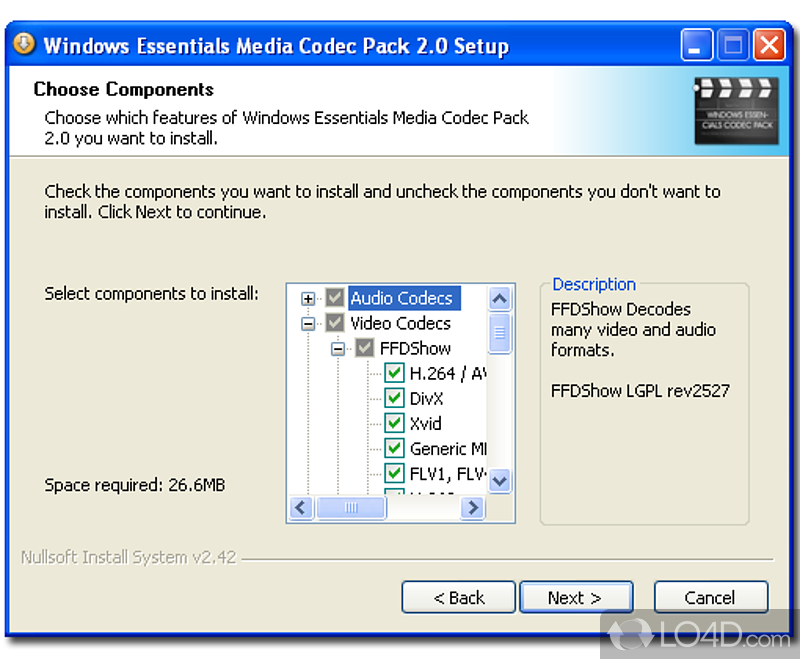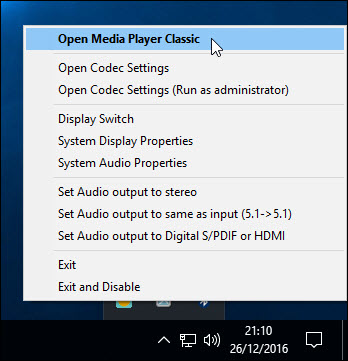- Microsoft Media Player Codec Pack Windows 10
- Microsoft Media Player Codecs For Windows 10 64-bit
- Microsoft Media Player Codecs For Windows 10 32-bit
- Windows 10 Video Player Codec

- 9 Go back to Windows Media Player and click the Close button on the original codec notice, and then click the red X to exit Windows Media Player. Ultimately, the codec is installed. 10 If you closed Windows Media Player, double-click the video or audio file again.
- Windows Media Player includes some of the most popular codecs, like MP3, Windows Media Audio, and Windows Media Video. However, it doesn't include the codecs required for Blu‑ray Disc files, FLAC files, or FLV files. If something isn’t working in Windows Media Player, you might not have the right codec.
- The best video codec packs for Windows 10 can help users effectively resolve an unsupported video playing file format issues. The Windows 10 Media Player supports a wide variety of multimedia file formats to include MP3, MP4, WMV, AVI, etc. However, there is a wide array of audio and video file formats in the market currently.
- Some of the circulating on the Internet, free codec packs are not mature or with malicious software. In the worst cases, these programs break the functionality of Windows Media Player. Start Windows Media Player as described above, and then click Tools on the menu bar.
More Information
With Windows Media Player 12 in Windows 7, you already have a very powerful tool for playing, managing, synchronizing and copying of video and audio files.
If you are using an earlier version of Windows such as Windows XP, we recommend that you install the current version of media player, to the benefit of all features and functionality.
Download - Windows Media Player for Windows XP

Play videos with Windows Media Player

The Media Player Codec Pack 4.5.6 is a simple to install package of codecs/filters/splitters used for playing back music and movie files. After installation you will be able to play 99.9% of files on the internet, along with XCD, VCD, SVCD and DVD.
It is very easy to play a video file by using Windows Media Player. If you save a video file on your hard disk, double-click the file to launch. You can watch videos on the Internet (such as the library of ARD or ZDF) by using Windows Media Player, you might need a small browser add-on program for it. To do this, follow these steps: more in the following parts of this series.
1. Click Start.
2. Type Media Player in the seach box.
3. Click Windows Media Player in the Programs list.
4. Windows Media Player is started. In the left navigation pane, you will find your Videos library. Click it to view all the video files associated with this library.
If the video you want to play is on your hard disk, but not in this library, you should add the video to the Videos library so taht you can access it at any time via the Windows Media Player. To do this, right-click Videos.
5. Click Manage Video library.
6. In the right pane, click Add, specify the location where you put your videos, and then click Include folder.
7. Click OK. All videos that you save in this folderare automatically added to the library.
8. Tip:To play a video file immediately in the media player and also automatically add it to the videos library, click the corresponding file entry in the Windows Explorer, right-click and then click Add to the Windows Media Player playlist.
Windows Media Player 12: Video codecs
To properly play video (and even music files), Windows Media Player required an appropriate codec. Codecs are small programs that encode digital signals in a file or data and decode. Only in this way, the player can interpret the streams as a music or film and play correctly. If a codec is missing in the system, the corresponding video file cannot be played. You will receive an error message.
Because Windows Media Player is well equipped with and all major audio and video formats - including 3GP, AAC, AVCHD, MPEG-4, WMV and WMA and AVI, DivX, mov, and XviD files, this error message generally does not appear.
Codec control
Microsoft Media Player Codec Pack Windows 10
You can easily control what codecs are already installed and ensure that the media player when loads automatically new codecs from the Internet.
1. Click Start.
2. Type Media Player in the search box
3. Click Windows Media Player.
4. The Windows Media Player is started. If the row that contains the menu commands is hidden, press [CTRL] and [M] at the same time. Then in the menu bar, click Help.
5. Click About Windows Media Player.
6. The following dialog box, click Technical Support Inoformation.
7. Windows Media Player opens then a technical details list view in your browser. Scroll to the Video Codecs section. You will see all codecs and file formats supported by the respective codec.
Microsoft Media Player Codecs For Windows 10 64-bit
Codecs have automatically installed
Microsoft Media Player Codecs For Windows 10 32-bit
You can configure the Windows Media Player so that it automatically downloads and installs updates and codec enhancements from the Internet when available. This makes more sense in most cases than manually in the Internet codec packs to search for. Some of the circulating on the Internet, free codec packs are not mature or with malicious software. In the worst cases, these programs break the functionality of Windows Media Player.
1. Start Windows Media Player as described above, and then click Tools on the menu bar.
2. Click Options.
3. On the Player tab, select either Once a day or Once a weekunder Automatic updates.
4. Click OK.
These codecs are for example used by the following applications:
- Movies&TV (a.k.a. Films&TV)
- Windows Photo Viewer
- Windows Media Player (can also use DirectShow codecs)
- Windows Explorer
- Adobe Premiere
Below you can download installers for several codecs. You can also get these exact same codecs in the Windows 10 store.
These codecs may fix:
Error 0xc00d005212 This item was encoded with a format that's not supported
HEVC video (a.k.a. H.265):
There are two versions of this codec. A free one and one that you can buy from Microsoft for $1 in the Windows 10 store. The free version only works on systems that have a graphics card (GPU) that is capable of hardware accelerated decoding of HEVC video.
Download [for 64-bit Windows] [free version] [requires a GPU capable of decoding HEVC]
Download [for 32-bit Windows] [free version] [requires a GPU capable of decoding HEVC]
Download in Windows 10 Store [$1]
VP9 video:
Download [for 64-bit Windows]
Download [for 32-bit Windows]
Windows 10 Store
Aomedia AV1 video:
Download [for 64-bit Windows]
Download [for 32-bit Windows]
Windows 10 Store

MPEG-2 video:

Download [for 64-bit Windows]
Download [for 32-bit Windows]
Windows 10 Store
HEIF/HEIC image:
Download [for 64-bit Windows]
Download [for 32-bit Windows]
Windows 10 Store
Webp image:
Download [for 64-bit Windows]
Download [for 32-bit Windows]
Windows 10 Store
You can install these Media Foundation codecs by simply double-clicking on the downloaded .appx file.
You can uninstall these codecs via Windows Settings. Same way as you uninstall other items downloaded from the Windows 10 store.
If you have a European N or Korean KN edition of Windows then you should also install the Media Feature Pack from Microsoft to gain additional multimedia functionality.
You can recognize these special versions of Windows by the fact that they do no include Windows Media Player by default.
Windows 10 Video Player Codec
You can acquire this media package through Windows settings:
Start > Settings > Apps > Apps & Features > Optional Features > Add a feature > Media Feature Pack